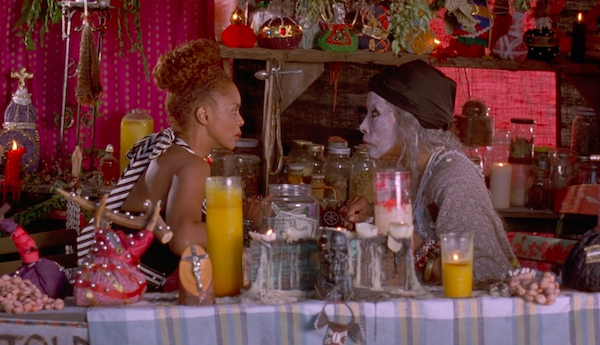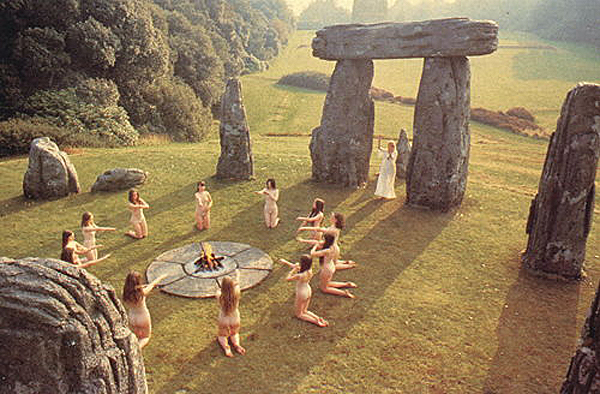Film Review: “Woodlands Dark and Days Bewitched” — Definitive Documentary on Folk Horror
By Peg Aloi
There’s no question in my mind that Woodlands Dark and Days Bewitched will remain the definitive work on the history of folk horror for many years to come.

A scene from 1997’s Eve’s Bayou.
The opening moments of Woodlands Dark and Days Bewitched: A History of Folk Horror do just what a documentary like this should do: immediately drop the viewer into a cauldron of sensations, drawing on folklore, music, and evocative imagery to stimulate the mind, stir the psyche, and stroke the viscera. To me, folk horror is not a defined genre so much as a lexicon of images, tropes, and topics that should spur a loosely-defined set of feelings and resonances. This stunning filmmaking debut will be a very thrilling excursion for fans who are undaunted by the prospect of a three hour long documentary that lovingly and studiously explores all things folk horror.
Although folk horror has become a very pervasive horror subgenre (several books have been written on the topic, and it has launched blogs, podcasts, and academic conferences), this is the first extensive, full length documentary on the subject. Filmmaker Kier-La Janisse (author of House of Psychotic Women: An Autobiographical Topography of Female Neurosis in Horror and Exploitation Films) has crafted a spellbinding tour de force that is stuffed full of history, context, and lots of thoughtful commentary. Woodlands Dark and Days Bewitched just received its world premiere at the South By Southwest film festival this week; it will soon be seen at more film festivals, if its initial enthusiastic reviews are any indication.
The film’s opening tone is odd — subtle but eerie. We watch an animated montage of pictures of nature (thorny trees, misty meadows, shadowy hedgerows) and hear a woman’s voice recite a strange poem about a wooded location. Then comes a mesmerizing musical introduction: the song “Magpie” sung by the traditional English folk band The Unthanks. It’s worth mentioning that at least fifteen years before folk horror became a notable trend, a subgenre of music known as wyrd folk — new music inspired by older recordings — was thriving. The lyrics of “Magpie” come from a common children’s rhyme; it is a form of divination modeled on counting the number of magpies seen in a tree: “one for sorrow, two for joy.” We hear this evocative spell unfold as we watch animated images created by British animator Ashley Thorpe (Borley Rectory). Later in the film, Canadian filmmaker Guy Maddin supplies paper animations. Woodlands Dark and Days Bewitched’s leads the viewer by the hand into folk horror territory (the “rural gothic,” as some have called it), as if through a path in the forest. We are invited to share the unsettling thoughts and emotions we find there, and it’s not an altogether unpleasant sensation.

Filmmaker and writer Kier-La Janisse, director of Woodlands Dark and Days Bewitched. SXSW Film.
Divided into chapter headings, the film initially explores the roots of the term “folk horror,” particularly the trio of British films that comprise the “unholy trinity” of its most fruitful era: Witchfinder General (1968), The Blood on Satan’s Claw (1971), and The Wicker Man (1973). Other sections delve into witchcraft and paganism, and American folk horror. Some critics charge that folk horror discourse has too often concentrated on mostly white, western European narratives. Thankfully, this documentary does an excellent job of expanding the conversation to include examples from other countries and cultures, discussing ways in which colonialism, slavery, and political oppression have served as folk horror tropes. One of the most intriguing segments here focuses on Bill Gunn’s beautiful, criminally neglected Ganga and Hess (1973), which was marketed as a “black vampire” film (a crudely-cut version was released under the title Blood Couple). The truth is that the film is an atmospheric and deeply layered odyssey that explores Black identity via the folklore of the African diaspora. The film also effectively examines folk horror on television, including extended series and made-for-TV films that contributed to the genre’s ’70s heyday and beyond.
The enormous amount of archival and media footage Janisse makes use of is nearly mind-boggling, but even more remarkable is the way that the film adroitly manages to tie all of folk horror’s strands together. The artful transitions and topnotch editing are particularly effective in making everything flow together with engaging precision. From cheesy ’70s fare like Psychomania to cult hits like The Reflecting Skin to arthouse fare like the recent Polish film Demon, and branching out into discussions of literature and history, the enduring archetypes of folk horror are illuminated with insights and anecdotes from the commentators, who are all erudite and enthusiastic. Woodlands Dark and Days Bewitched eschews the frippery of fandom and tales of behind the scenes strangeness to focus keenly on the subject at hand: where did folk horror come from — and what is its future?

A scene from 1973’s The Wicker Man.
The film contains a dizzying number of film and video clips (horror buffs will want to keep a pen and paper handy to jot down the titles). The fascinating analysis includes contributions from various filmmakers (such as Piers Haggard, director of The Blood on Satan’s Claw, Robert Eggers, director of The Witch, and Janisse herself) along with insights supplied by authors, scholars, critics, and artists. The clips and commentary are woven together almost seamlessly; there are interstitial interludes made up of evocative music, poetry recitations, and haunting animations and montages. Throughout Woodlands Dark and Days Bewitched there is a sense that all of the material under discussion overlaps somehow, that it is part of a vast repository of ancient knowledge and imagery re-imagined by contemporary artists. The film acknowledges a belief shared by many fans of folk horror, who point to the genre’s uncanny power to get underneath our skin because its images are rooted in the elemental connection to nature: an idea not far removed from Jung’s conception of the collective unconscious. Some viewers might notice an omission or two (where is The Blair Witch Project? Trollhunter? Walkabout?). Of course, some omissions were inevitable; yet this documentary is impressively comprehensive. There’s no question in my mind that Woodlands Dark and Days Bewitched will remain the definitive work on the history of folk horror for many years to come.
Peg Aloi is a former film critic for the Boston Phoenix and member of the Boston Society of Film Critics. She taught film studies in Boston for over a decade. She writes on film, TV, and culture for web publications like Vice, Polygon, Bustle, Mic, Orlando Weekly, Crooked Marquee, and Bloody Disgusting. Her blog “The Witching Hour” can be found at themediawitch.com.

[…] Variety ReviewScreen Anarchy ReviewBloody Disgusting ReviewIndiewire ReviewAustin Chronicle ReviewRogerEbert.com ReviewDread Central ReviewAV Club Capsule reviewSlashFilm ReviewMashable ReviewConsequence of Sound ReviewDaily Grindhouse ReviewTilt ReviewCinapse reviewIGN ReviewFilm Threat ReviewGizmodo ReviewScreamcast ReviewFilm Pulse ReviewArts Fuse Review […]
[…] Variety ReviewScreen Anarchy ReviewBloody Disgusting ReviewIndiewire ReviewAustin Chronicle ReviewRogerEbert.com ReviewDread Central ReviewAV Club Capsule reviewSlashFilm ReviewMashable ReviewConsequence of Sound ReviewDaily Grindhouse ReviewTilt ReviewCinapse reviewIGN ReviewFilm Threat ReviewGizmodo ReviewScreamcast ReviewFilm Pulse ReviewArts Fuse Review […]
[…] Source link […]
Great review. “Woodlands…” is more than just a documentary especially that opening which you do a wonderful job of describing. I know I’ll enjoy “Woodlands…” again and again.
“What if the old ways were right?”